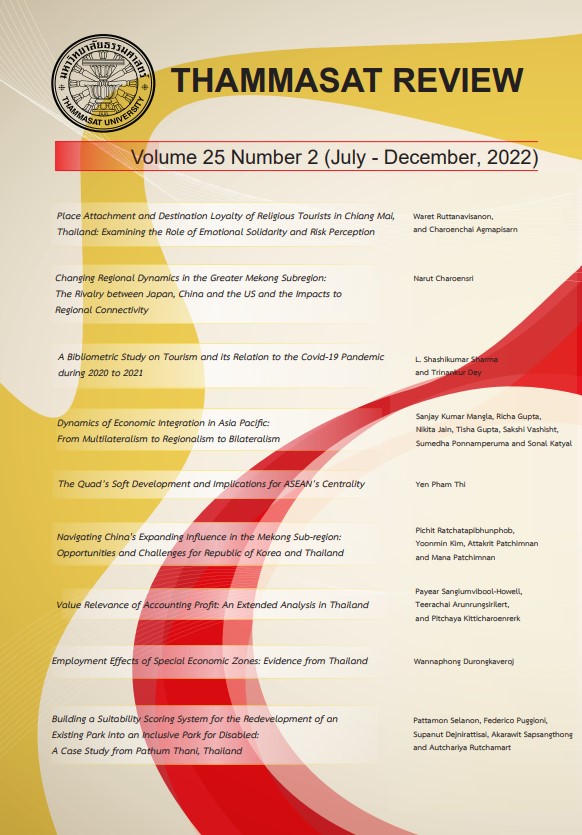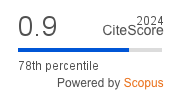Changing Regional Dynamics in the Greater Mekong Subregion: The Rivalry between Japan, China and the US and the Impacts to Regional Connectivity
Keywords:
China, Japan, Free and Open Indo-Pacific, Greater Mekong Subregion, ConnectivityAbstract
This paper analyses the impact of the economic and political rivalry between Japan, China and the US upon the Greater Mekong Subregion (GMS). The rivalry is part of the amicable and hostile relations between superpowers within the international system and has significant impacts on regional economic and political arrangements. The emergence of the ‘Free and Open Indo-Pacific’ (FOIP) by Japan was welcomed by the US, India, and Australia and brought new factors and conditions to the region. Many scholars argue that the FOIP was a strategy to balance China’s power in the region. The growing power of China’s regional development projects under the Belt and Road Initiative (BRI) change the geopolitical and geo-economics configuration in the region significantly. BRI itself integrates many parts of the world into China’s international production network and sphere of influence. This paper argues that the geopolitical rivalry between Japan, China and the US shaped the regional connectivity development in the GMS area. It integrated the GMS into broader geopolitical and geopolitical strategies which are FOIP and China’s BRI.
References
ADB & ADBI. (2009). Infrastructure for a seamless Asia. Asian Development Bank Institute.
Aiyara, T. (2019). The long and winding railway: Domestic politics and the realisation of China-initiated high-speed railway projects in Thailand. Chinese Political Science Review, 4, 1-22. https://doi.org/10.1007/s41111-019-00124-2
ASEAN. (2011). Master plan on ASEAN connectivity. The ASEAN Secretarait.
ASEAN. (2016). Master plan on ASEAN connectivity 2025. The ASEAN Secretariat.
Australian Government. (2017). 2017 Foreign policy white paper. Department of Foreign Affairs and Trade. https://www.dfat.gov.au/publications/minisite/2017-foreign-policy-white-paper/fpwhitepaper/pdf/2017-foreign-policy-white-paper.pdf.
Bangprapa, M. (2020, October 28). High-speed trains 'will boost the economy'. https://www. bangkokpost.com/business/2010031/high-speed-trains-will-boost-the-economy
World Bank. (2017). The status of infrastructure services in East Asia and the Pacific. World Bank.
Blanchard, J.-M. F. (2018). China’s Maritime Silk Road Initiative (MSRI) and Southeast Asia: A Chinese ‘pond’ not ‘lake’ in the Works. Journal of Contemporary China, 27(111), 329-343. https://doi.org/10.1080/10670564.2018.1410959
Brown, J. D. J. (2018, April 3). Japan’s Indo-Pacific strategy falls short. https://www. japantimes.co.jp/opinion/2018/04/03/commentary/japan-commentary/japans-indo-pacific-strategy-falls-short/
Chang, F. K. (2013). The Lower Mekong Initiative & U.S. foreign policy in Southeast Asia: energy, environment & power. Orbis, 57(2), 282-299. https://doi.org/https://doi. org/10.1016/j.orbis.2013.02.005
Charoensri, N. (2014). botbāt saha ratʻamērikā thī mī tō̜ kān kœ̄t khưn khō̜ng phūmiphāk niyom nai Yurōp læ ʻĒchīa tawanʻō̜k chīang tai [The US Roles towards the Establishment of Regionalism in Europe and Southeast Asia]. (Bangkok: Centre for European Studies at Chulalongkorn University)
Charoensri, N. (2016). prachākhom ʻĒchīa tawanʻō̜k phāitai ERIA : botbāt khō̜ng Yīpun tō̜ khlang samō̜ng kap kānphatthanā prachākhom ʻĒchīa tawanʻō̜k [East Asia Community under ERIA: The Role of Japan towards Think Tanks and the Development of East Asia Community]. Thai Journal of East Asian Studies, 20(1), 67-98. https://so02.tci-thaijo.org/index.php/easttu/article/view/81138
Charoensri, N. (2018). phūmiphāk sāthāranūpaphōk phatthanā withēt khadī : botbāt Yīpun kap kānphatthanā rabop kān khonsong rawāng prathēt læ phon tō̜ phūmiphāk niyom nai ʻĒchīa tawanʻō̜k chīang tai [The International Affairs of the Regional Infrastructure Development: The Role of Japan towards Regional Infrastructure Development and Its Impacts on Southeast Asian Regionalism]. Greater Mekong Subregion Studies Centre, Faculty of Political Science and Public Administration, Chiang Mai University
Charoensri, N. (2019). sip pī khwāmsamphan lumna khōng kap Yīpun : čhāk khwāmsamphan thawi phūmiphāk sū kān chư̄amyōng phūmphākhāphiwat [Ten Years of Mekong-Japan Relations: From “Bi-Regional Relations’ to ‘Linked Regionalisation”]. Political Science and Public Administration Journal, 10(1), 149-194. https://so05.tci-thaijo.org/index.php/polscicmujournal/article/view/165196
Charoensri, N. (2021a). ʻin dō - pǣsifik nai krasǣ kān plīanplǣng : yutthasāt FOIP khō̜ng Yīpun thī mī tō̜yut sāt khō̜ng saha rat læ Čhīn læ phonkrathop tō̜ Thai [Indo-Pacific in the Transforming Time: Japan’s FOIP Strategy towards the US and China, and Its Impacts to Thailand]. Japan Watch Project.
Charoensri, N. (2021b). Transforming (sub) regional order(s): The three-layered order of the Greater Mekong Subregion. Social Transformations: Journal of the Global South, 9(1), 23-43. https://doi.org/https://dx.doi.org/10.13185/STJGS2021.09103
Chellaney, B. (2018). Japan’s pivotal role in the emerging Indo-Pacific order. Asia-Pacific Review, 25(1), 38-51. https://doi.org/10.1080/13439006.2018.1475714
Chhengpor, A. (2018, March 23). Japan links Mekong and ASEAN to Indo-Pacific strategy. https://www.voacambodia.com/a/japan-links-mekong-and-asean-to-indo-pacific-strategy/4312857.html
Choong, W. (2019). The return of the Indo-Pacific strategy: an assessment. Australian Journal of International Affairs, 73(5), 415-430. https://doi.org/10.1080/10357718. 2019.1639134
Cronin, R., & Hamlin, T. (2012). Mekong turning point: Shared river for a shared future. The Henry L. Stimson Center. https://www.stimson.org/wp-content/files/file-attachments/SRSF_Web_3_1.pdf
State Department. (2019, November 3). A Free and Open Indo-Pacific: Advancing a shared vision. https://www.state.gov/wp-content/uploads/2019/11/Free-and-Open-Indo-Pacific-4Nov2019.pdf
Er, L. P., & Teo, V. (2012). Southeast Asia between China and Japan. Cambridge Scholars Publishing.
Fujita, M. (2021). Can ASEAN retain centrality in Indo-Pacific region? - From a GVC point of view. Journal of Contemporary East Asia Studies, 10(1), 108-122. https://doi.org/ 10.1080/24761028.2021.1892964
Harper, T. N. (1997). 'Asian Values' and Southeast Asian histories. The Historical Journal, 40(2), 507-517. http://www.jstor.org/stable/2640078
Hosoya, Y. (2019). FOIP 2.0: The Evolution of Japan’s Free and Open Indo-Pacific Strategy. Asia-Pacific Review, 26(1), 18-28. https://doi.org/10.1080/13439006.2019.1622868
International Development Centre of Japan Inc. (2018). Evaluation on Japan's Assistance to Connectivity in the Mekong Region with a Focus on the Southern Economic Corridors. Tokyo: Ministry of Foreign Affairs, Japan.
Isono, I. (2010). "Economic Impacts of the Economic Corridor Development in Mekong Region" in investment climate of major cities in CLMV countries. I. Masami.
Jones, D. M. (2018). Between declarations and dreams China, US foreign policy and Southeast Asia. Policy, 34(1), 43-50.
Katagiri, N. (2020). Shinzo Abe's Indo-Pacific Strategy: Japan's recent achievement and future direction. Asian Security, 16(2), 179-200. https://doi.org/10.1080/14799855. 2019.1607304
Kessides, C. (1993). The contributions of infrastructure to economic development . The World Bank. https://doi.org/doi:10.1596/0-8213-2628-7
Kim, M.-h. (2019). A real driver of US–China trade conflict: The Sino–US competition for global hegemony and its implications for the future. International Trade, Politics and Development, 3, 30-40. https://doi.org/10.1108/ITPD-02-2019-003
Kitaoka, S. (2019). Vision for a Free and Open Indo-Pacific. Asia-Pacific Review, 26(1), 7-17. https://doi.org/10.1080/13439006.2019.1618592
Lauridsen, L. (2019). Changing regional order and railway diplomacy in Southeast Asia with a case study of Thailand. In L. Xing (ed.). Mapping China's 'One Belt One Road' Initiative (pp. 219-248). https://doi.org/10.1007/978-3-319-92201-0_9
Lee, L. (2019). Democracy promotion: ANZUS and the Free And Open Indo-Pacific strategy. https://www.ussc.edu.au/analysis/democracy-promotion-anzus-and-the-free-and-open-indo-pacific-strategy
Leng, T. (2020). Connectivity initiatives in the Mekong Region: Too many or too little? Singapore: Konrad-Adenauer-Stiftung.
Makishima, M. (2010). Japan's ODA to Mekong River Basin Countries: With Case Studies. In M. Kagami (ed.). Japan and Korea with the Mekong River Basin Countries (294-327). Bangkok: IDE-JETRO, Bangkok.
Masami, I. (2012). Emerging economic corridors in the Mekong Region. IDE-JETRO.
METI. (2008). White paper 2008: Section 5: promoting the concept of “Asian economic and environmental community”. https://www.meti.go.jp/english/report/downloadfiles/2008 WhitePaper/4-5.pdf
METI. (2009). White paper 2009: Section 2: Four priorities for foreign economic policy. https://www.meti.go.jp/english/report/downloadfiles/2009WhitePaper/3-2-1.pdf
METI. (2010). White Paper 2010: Chapter 2: Japan growing with Asia’s Development –Asia-Pacific framework towards sustainable growth, Section 4: Japan’s contribution to the infrastructure development in Asia. https://www.meti.go.jp/english/report/ downloadfiles/2010WhitePaper/2-4-2.pdf
Miller, J. B. (2019). Japan’s changing vision of a Free and Open Indo-Pacific. Global Asia, 14(1), 70-73. https://www.globalasia.org/v14no1/feature/japans-changing-vision-of-a-free-and-open-indo-pacific_j-berkshire-miller
MOFA. (1992, June 30). Official development assistance (ODA). http://www.mofa.go.jp/ policy/oda/summary/1999/ref1.html
MOFA. (2016, August 27). Addressing by Prime Minister Shinzo Abe at the opening session of the sixth Tokyo nternational conference on African development (TICAD VI). https://www.mofa.go.jp/afr/af2/page4e_000496.html
MOFA. (2019,August 27). Towards Free and Open Indo-Pacific. https://www.mofa.go.jp/files/ 000407643.pdf
Nakao, T. (2015). Eight key conditions for economic development. Milken Institute.
Parameswaran, P. (2019, November). Advancing democracy in the US Free and Open Indo-Pacific Strategy. The Diplomat. https://thediplomat.com/2019/04/advancing-democracy-in-the-us-free-and-open-indo-pacific-strategy/
Rix, A. (2013). Japan's foreign aid challenge: Policy reform and aid leadership. Routledge.
Satake, T. (2019). Japan’s “Free and Open Indo-Pacific strategy” and its implication for ASEAN Southeast Asian affairs 2019 (D. Singh & M. Cook, Eds), (pp. 69-82). ISEAS Publishing. https://doi.org/doi:10.1355/9789814843164-007
Satake, T., & Sahashi, R. (2021). The rise of China and Japan’s ‘Vision’ for Free and Open Indo-Pacific. Journal of Contemporary China, 30(127), 18-35. https://doi.org/10. 1080/10670564.2020.1766907
Sawamura, N. (2004). Japan's philosophy of self-help efforts in international development cooperation: Does it work in Africa? https://www.researchgate.net/publication/ 237420039_Japan's_Philosophy_of_Self-Help_Efforts_in_International_ Development_Cooperation_Does_It_Work_in_Africa
Office of the Press Secretary (2014). FACT SHEET: U.S.-Japan global and regional cooperation. https://obamawhitehouse.archives.gov/the-press-office/2014/04/25/ fact-sheet-us-japan-global-and-regional-cooperation
Shah, R. (2020). Will the Indo-Pacific strategy besiege China? Australian Journal of Maritime & Ocean Affairs, 12(3), 125-137. https://doi.org/10.1080/18366503.2020.1782806
Shambaugh, D. (2021). Where great powers meet: America and China in Southeast Asia. Oxford University Press. https://doi.org/10.1093/oso/9780190914974.001.0001
Siddiqui, H. (2019). India’s concept of Indo-Pacific is inclusive and across oceans. Ministry of External Affairs. Retrieved 16 August from https://mea.gov.in/articles-in-indian-media. htm?dtl/32015/indias+concept+of+indopacific+is+inclusive+and+across+oceans
Sonoura, K. (2017). Japan’s initiatives for promoting “quality infrastructure investment”.
https: //www.mofa.go.jp/files/000291344.pdf
Office of the Spokesperson (2019, August 2). Strengthening the U.S.-Mekong Partnership. https://asean.usmission.gov/strengthening-the-u-s-mekong-partnership/
U.S. Department of State (2021, April 6). Integrating democracy, human rights, and good governance in efforts to address climate chang and protects the environment in the East Asia and Pacific region. https://www.state.gov/statements-of-interest-requests-for-proposals-and-notices-of-funding-opportunity/integrating-democracy-human-rights-and-good-governance-in-efforts-to-address-climate-change-and-protect-the-environment-in-the-east-asia-and-pacific-region/
Tan, A. H. H. (1970). Alternative in Southeast Asia. By Eugene R. Black. Pall Mall Press, London1969. Pp. xv + 180. Preface, Maps. Journal of Southeast Asian Studies, 1(2), 140-142. https://doi.org/10.1017/S0022463400020385
Tantayakul, S. (2018). botbāt khlang samō̜ng nai krabūankān kamnot nayōbāi sāthārana khō̜ng Čhīn : kō̜ranī sưksā khō̜rirœ̄m thǣp sētthakit læ sēnthāng sāimai yuk mai [The Roles of Think Tanks in China’s Policy Making Process: A Case Study of Belt and Road Initiative]. The Thai-Chinese Strategic Research Centre (TCRC), National Research Council of Thailand (NRCT).
Tay, S., & Wau, J. (2020). The Indo-Pacific Outlook: a new lens for ASEAN. East Asia Forum Quarterly, 12(1), 3-5. https://www.eastasiaforum.org/2020/04/20/the-indo-pacific-outlook-a-new-lens-for-asean/
Tsuneishi, T. (2009). Border trade and economic zones on the North-South economic corridor: Focusing on the connecting points between the four countries. Institute of Developing Economies, Japan External Trade Organisation(JETRO), IDE Discussion Papers.
USAID. (2021, November 29). Lower Mekong Initiative (LMI). https://www.usaid.gov/asia-regional/lower-mekong-initiative-lmi#:~:text=The%20Lower%20Mekong% 20Initiative%20(LMI,shared%20challenges%20in%20the%20region
Yanagida, K. (2020). Strengthening US-Japan-Southeast Asia cooperation on connectivity in the Indo-Pacific. https://www.eastwestcenter.org/publications/strengthening-us-japan-southeast-asia-cooperation-connectivity-in-the-indo-pacific
Yennie-Lindgren, W. (2019). Old sake, new barrel?: Japan’s Free and Open Indo-Pacific strategy. In S. Stirling (Ed.), Mind The Gap: National Views Of The Free And Open Indo-Pacific (pp. 35–39). German Marshall Fund Of The United States. http://www.jstor.org/stable/resrep 21474.9
Yennie Lindgren, W. (2021). Win-win! with ODA-man: legitimizing development assistance policy in Japan. The Pacific Review, 34(4), 633-663. https://doi.org/10.1080/ 09512748.2020.1727552
Yoshida, Y. (2008). ASEAN logistics network map. https://www.jetro.go.jp/malaysia/activities/ aseanlogistics/index.html/aseanlogmap.pdf
Yu, Y.-W. (2020). Indonesia’s response toward U.S.’s Indo-Pacific strategy in the context ofr rising China. Tamkang Journal of International Affairs, 23(4), 161-176. https://tkuir. lib.tku.edu.tw/dspace/retrieve/146873/Indonesia%27s+Response+toward+U.S.%27s+Indo-Pacific+Strategy++in+the+Context+of+Rising+China.pdf
Zhao, H. (2019). China–Japan compete for infrastructure investment in Southeast Asia: Geopolitical Rivalry or Healthy Competition? Journal of Contemporary China, 28(118), 558-574. https://doi.org/10.1080/10670564.2018.1557946
Downloads
Published
How to Cite
Issue
Section
License
Copyright (c) 2022 Thammasat Review

This work is licensed under a Creative Commons Attribution-NonCommercial-NoDerivatives 4.0 International License.
The opinions and ideas expressed in all submissions published in Thammasat Review are solely that of the author(s) and do not necessarily reflect that of the editors or the editorial board.
The copyright of all articles including all written content and illustrations belong to Thammasat Review. Any individuals or organisation wishing to publish, reproduce and distribute a particular manuscript must seek permission from the journal first.








